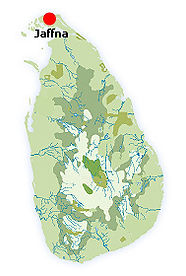JAFFNA
A bastion of Hindu tradition, art and creative culture, Jaffna welcomes visitors warmly. It’s intriguing, unimposing, slightly off the beaten path and a thoroughly rewarding place to discover Sri Lankan Tamil culture.
Inescapably, decades of war, emigration, embargoes and loss of life and property deeply affected this historic town, but the city is surprisingly green and leafy, with attractive palm-shaded colonial-era suburbs and beautiful temples and churches. Physically, new projects and upgraded transport connections show that Jaffna's days of isolation are long past.
Ancient sights both in the centre of town and on the outskirts make for compelling attractions. And while there is enough to do after dark to create a nascent buzz, it's still mellow enough that you won't get run over while walking.
The city is an ideal base for forays to the idyllic islands just to the west and trips along the

Jaffna Information and Google Map
PROVINCE : NORTHERN PROVINCE
DISTRICT : JAFFNA DISTRICT
POPULAR : BEACH,FORT,TEMPLES
WEATHER : 33 °C
PHOTO GALLERY
Historical Background
Once the 2nd largest Sri Lankan city, it was also an important Portuguese colonial hold. The Dutch Fort that still dominates the Jaffna skyline is spread over an area of 22 hectares within the city limits. The star shaped Jaffna Fort built in 1680 by the Dutch is considered as the best example of Dutch fortifications in Asia.
In Delft Island (Neduntivu islet) 35 kms from the city is the Delft Fort built by the Portuguese. Behind the Fort is a beautiful beach with exquisite shells. A ferry service connects the largest island in the Palk straits with the mainland. The architecture of the Kandaswamy Kovil in the Nallur quarter of the city has been built in the South Indian Dravidian style. The shrine which stood on the site before its destruction by the Portuguese dates back to the 10th century.At Kantarodai, there are about 100 miniature dagobas or stupas crowded in to an area of about one hectare. The diameter of the largest stupa is approximately 4 meters. These are believed to be 2000 years old.Nagadeepa is a small island an hour’s journey by boat from the city.
Shopping
Explore Jaffna market where villages sell everything from homegrown fruits and vegetables to hand-woven baskets made of Palmyra palm leaves. Wade through the narrow walkways and you’ll come across stalls filled with Jaffna sweets, juggery, treacle, Jaffna spices, fruit cordials, and even wine made by the Rosarian nuns using locally-grown grapes. The small shops surrounding the market sell colourful saris, sarongs, kurtas, and textiles from south India. There is also the jeweller’s street nearby with glass cabinets filled with glistening gold bangles and necklaces.
Events
Many larger Hindu kovils hold pageants from July to December. During these colourful festivals, the temple deity is paraded in an elaborate chariot. The festival conducted by the Nallur Kandasamy Kovil goes on for 26 days in August. Devotees in their thousands from all over Sri Lanka attend this festival. The Buddhist sites come alive especially during Vesak on full-moon day in May in veneration of the life of Lord Buddha - his birth, enlightenment and passing away; and in June (Poson) when the introduction of Buddhism 2,500 years ago is commemorated. Bird watching in Jaffna from September to March is a highlight for nature lovers. Migrant birds along with other waders flock to the lagoons.
Climate
The temperature is at its highest during April/May and August/September. The North East monsoon rains are between October to January. Best time to visit is towards end of the year when the lagoons are filled with water, the paddy fields and vegetation are lush green, the air is cooler and the migrant birds including Flamingos, ducks and other waterbirds line the lagoons in their thousands. Birding season in the Jaffna peninsula is from about September to March.
Sights
Jaffna town, with its maze of narrow roadways, is easy to get about with a good map in hand. The ancient Nalllur Kandasamy kovil, St. Mary’s Cathedral, Jaffna Fort and Jaffna’s Archeological Museum are some of the more interesting sites. Drop by Jaffna market for souvenirs and handicrafts.
Head North on the Kankesanturai (KKS) road to Point Pedro with its lighthouse staring out to the Bay of Bengal. The ancient Naguleswaram Shiva kovil, Keerimalai hot springs and ruins of the Kanthrodai Buddhist temple are all. The more adventurous head North East – a remote area where the sand dunes of Manalkadu are scattered with Casuarina trees. The ruins of the Portuguese-period St Anthony’s church and burial grounds rise up from the sands creating a unique landscape.
West of Jaffna town can be accessed via the Karainaragar causeway. Birding during the migrant season can be utterly rewarding. Spend a morning’s excursion exploring the Vaddukoddai Portuguese church; Punnalai Varatharaje Perumal Kovil, and the sandy beaches of Casuarina north of Karainagar. Stop by for lunch at Fort Hammenhiel – a Portuguese-period fort built in the sea.
The Jaffna islands are also fascinating. Spend a day out at Delft Island with its small village homes, wild horses that roam the plains, and ruins of a Portuguese Fort. Nainativu Island is easier to access and is home to the ancient Nagadeepa Buddhist temple and the Naga Pooshani Ambal Hindu temple.








